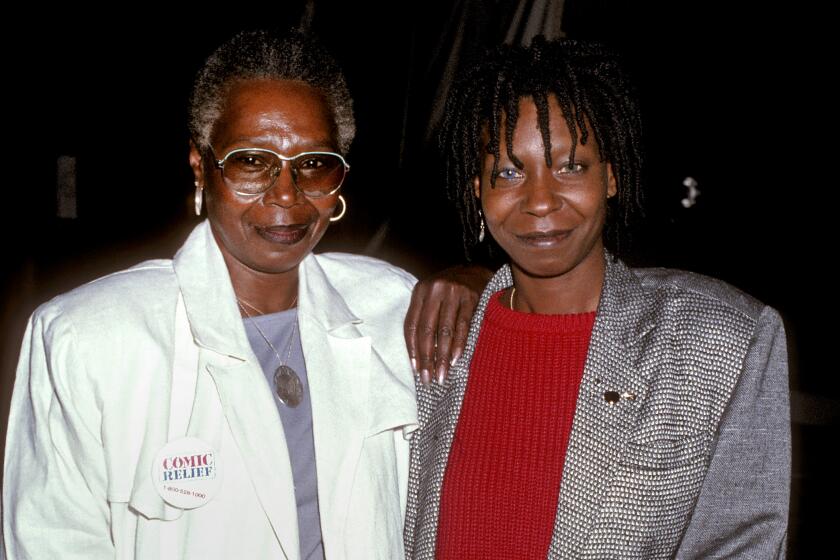The Hidden Significance of Supper : MUCH DEPENDS ON DINNER : The Extraordinary History and Mythology, Allure and Obsessions, Perils and Taboos of an Ordinary Meal <i> by Margaret Visser (Grove Press: $19.95; 351 pp.) </i>
Timing is everything, they say, and Margaret Visser’s book is living testimony that there is no better time, nor has there been a better time, historically speaking, for a book that dissects nine everyday foods we take for granted. The same book, published 20 years sooner, might have been stamped as eccentric babbling by some deadened food critic of that gloomy food period and found its way much sooner to the musty, dusty sales bins to be lost and forgotten forever.
Today’s foodies are hungry for more than food. They really thirst for knowledge of the food they love to consume and with which they are obsessed these days. Where else can they get to read about their favorite topic as they would a lusty novel, filled with intrigue, adventure and hilarity?
Visser’s book, a storehouse--chock-full and brimming--of fascinating information, is presented in a cannon-blast style. Ideas, insights and information fairly tumble out of the pages, without the benefit of order suggested by the strict encyclopedic format. The lack of structure, however, is both the book’s asset and liability.
The free abandon of the style, in fact, belies any difficulties of research undoubtedly experienced. The book simply sails along, sometimes in an overwhelmingly chaotic, other times sanely smooth manner, from first course of corn with butter to the finale--ice cream. You may not want to put it down.
Visser, who stumbled on the idea of the book after peeling onions and wondering why they smelled strong; why some were red, others not; where they came from and whom they sustained, describes herself as “an anthropologist of everyday life.” She was born in South Africa, was educated in Zambia and Zimbabwe and studied at the Sorbonne in Paris. She also lived, oddly, in Baghdad until she settled with her husband in Toronto where she began a broadcasting career.
She decided, after researching numerous foods, to single out an everyday menu eaten universally in the Western world and dissects the basic ingredients of corn-on-the-cob with salt and butter, chicken with rice, lettuce with olive oil and lemon dressing and a dessert of ice cream.
You get not only the exploration of myth and legend, the anthropology and history of the food, but Visser forces you to consider the effect of these everyday foods on the modern world. The economic and political dangers lurking behind innocent kernels of corn. “The triumphs of crop uniformity and genetic engineering; the salting and pollution of the desperately precious fertile areas of the Earth; the destruction of cultural tradition and the replacement of it by--what else?--replaceability (sic); democratization being turned into the enemy of culinary excellence; farm mechanization and the loss of human livelihoods; cheap meat versus animal rights; food irradiation, additives, antibiotics, herbicides and pesticides and the angry distrust they can arouse in us.”
She had meant, confesses Visser, for the book to be amusing, but often found herself outraged and in fear.
Well, you will be, too, when you learn that the dependence of corn production on artificial fertilizers, and disappearing varieties threaten the future of corn. There is more to corn than buttering it, after all. Indeed, the American temperament would have created its life style of something else if corn had not existed, for it was corn, the crop that native American Indians deified and named “our mother, our life,” that spearheaded the expansion of modern technology in America, with its uses as feed to the enormous livestock industry, as a sweetener and food coloring, and in soap, insecticides, food products and textiles among many other uses. It was corn, in the form of pressed flakes that helped launched the multibillion dollar cold cereal industry as we know it today. America, after all, produces nearly half the world supply of corn. But you learn that corn has its innate weakness, for unlike other crops that reseed themselves, corn requires the help of man to propagate.
Visser describes the drama behind the butter and margarine industrial battles, their beginnings and final resolution. You even get a brief course in the cholesterol issue as it pertains to butter versus margarine.
You might wonder what anyone could say about the chicken that would be captivating enough to sit through a chapter of its history, mythology, custom and politics. But there you are glued to the pages describing how the 2-pound feathery creature of 2,000 B.C. traveled from the forests of northern India, across millennia of time to present-day Southern California where chickens might appear boneless, skinless and formless for today’s consumption.
We learn that lettuce seeds came to America via Europeans, perhaps by Columbus himself, for there is a record of lettuce being cultivated in the Bahamas in 1494. The lettuce industry in America, requiring human labor for its production, is controversial to this day, belying its innocent symbolism as a feminine--but cold--food, according to Visser. Still, its status as a newly appreciated “gourmet” food for health-minded individuals, puts lettuce among the top five “taste trends” in the United States, with seafood, chicken, fresh vegetables and fruit following.
On the light side, Visser attributes a sex to each of the foods. “. . . our meal is almost totally female in connotation. Corn is the American Indian mother and nourisher. Chicken (pale meat, no red blood, and little fat in evidence) is for us a typically female choice; rice, a delicate grain--especially when it is ‘fluffy,’ as we like it--white like chicken--and in its mythical origins (though not in our culture) a girl-child; lettuce is light and unfattening, but also cold, green and (therefore) female; lemons nippled, olive oil virgin, ice cream cold, milk, and served in definitely womanly, rounded shapes. Salt is the one exception, but even it is neuter and not masculine, butter from cream is again female.”
Olive oil, which enhanced the sexual attraction of lovers in mythology and anointed Popes and priests throughout Christendom, has, in the 20th Century, come into its own as a healthful oil for consumption. Visser explains that Northern Europeans, who belong to butter cultures, only recently discovered the taste aesthetics and health benefits of olive oil. Until recently, mono-unsaturated fat, such as olive oil, was ignored in the cholesterol debate. Experiments now suggest that mono-unsaturated oil may be the healthiest choice of all.
Visser claims that ice cream has become a great indulgence because its myth of innocence remains intact. “It is a safe drug, an antidote to anxiety--to stress, for example, of having to be thin. We feel that reality is now something for which we have to pay a high price; but we doggedly, even touchingly, wish that reality could be innocent.”
Like her book.
More to Read
Sign up for our Book Club newsletter
Get the latest news, events and more from the Los Angeles Times Book Club, and help us get L.A. reading and talking.
You may occasionally receive promotional content from the Los Angeles Times.






